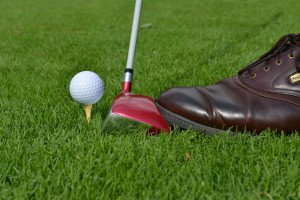While helping his kids get started in golf, New Jersey amateur Brian Selfridge came up with a training aid, the Slotted Driver, that he thinks will help others, especially beginners, get off on the correct path when concentrating on tee box performance.
When Selfridge decided to help his boys get started with the right golf fundamentals, he had problems ensuring his oldest son Justin correctly aligned his body square to the ball while ensuring the driver’s face stayed square to the target down the range also. So he began stepping on the back of a traditional driver to help him aim down the range. Working with autistic son Benjamin, he also stepped on the back of the driver to gain control of the training environment and was able to settle him down enough to make sure the face was square to the target and used both hands to ensure he was in the correct address position.
Selfridge explained that autism is a disease now affecting 1 of every 66 kids in the U.S., an epidemic.
Explaining how the training aid evolved, Selfridge said, “During one training session, I imagined a place for my foot on the back of the driver head, like a ‘slot’ had been removed for my foot.”
 Working with club designer, Jeff Sheets, they came up with a driver with a cavity on the back that would allow a teacher to comfortably gain control of the driver with his foot only.
Working with club designer, Jeff Sheets, they came up with a driver with a cavity on the back that would allow a teacher to comfortably gain control of the driver with his foot only.
“It’s like training wheels for new golfers,” Selfridge explained. “I liken it to the initial experience a kid might get in the batter’s box. Most, if not all, need their hands and body aligned correctly before they can hit a ball off a tee or a pitched baseball or softball. We’ve taken that same principle and applied it to golf, solving the problem of ensuring the driver face stays square to the target during training and then when aiming on the golf course.”
Selfridge believes the Slotted Driver can also be used by the serious players since the weight is clearly low and forward and it currently conforms to regulations set by the United States Golf Association. “There are cavity back irons for game improvement,” he added. “Why not cavity back drivers for improvement and performance.”
At the ING Spring Conference in Atlantic City, Selfridge indicated that the drivers, featuring a loft of 18 degrees, would be in production later in the summer and available to the public by the fall at $119 for adults and $99 for juniors.
Selfridge believes others can use his training system, too:
With your right foot, step into the Slotted Driver by Step Into Golf while facing the target.
Turn towards a right-handed golfer off to you left by shifting your position 45 degrees open or greater.
Invite the golfer to step into the address position while releasing the grip so he or she can assume the correct grip.
Set the new golfer into a great address position, using your best judgment. Include advice on the grip.
Using your discretion, remove your foot and clear the area to let the golfer swing away while coaching them to be athletic.
After a few training sessions, step into the driver with your left foot. This allows you to provide more help with aiming. Be sure to step out and away when the golfer gets ready to swing.
